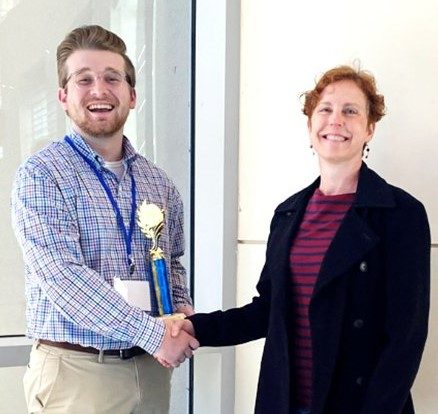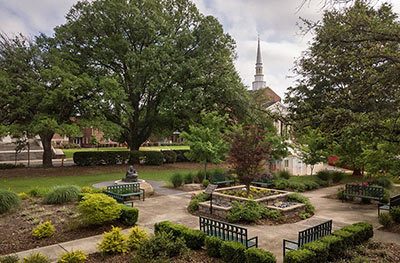Fruits of MC’s Discovery Enterprise Garner Awards During Statewide Scientific Meeting

Mississippi College scholars drew significant attention when scientists from across the Magnolia State gathered to review the latest research findings from hundreds of students during the Mississippi Academy of Sciences 86th annual meeting March 31-April 1 in Biloxi.
Hunter Matkins, an undergraduate biology student in Dr. Erik Bourassa’s lab, took first place in the Neuroscience Division for his project, “Test Anxiety is Associated with a Decreased Error-Related Negativity in Tasks Requiring Top-Down and Bottom-Up Attention.”
The study hypothesized that students with test anxiety would have a larger ERN than students without TA and that the change in ERN would be larger in tasks requiring top-down attentional control. The data suggest that in students with TA, conflict monitoring may be hypofunctional and therefore goal-oriented behavior may be less amenable to correction.
Emily Sullivan and Megan Stewart, chemistry students in Dr. David Magers’ lab, also placed in the Top 20 of undergraduate researchers for their project in computational chemistry.
Dr. Scoty Hearst, MC assistant professor of chemistry and biochemistry and 2021-22 vice-chair of neuroscience for the MAS, said MC’s significant participation in the scientific meeting helps bolster the Christian University’s standing within the scientific community. MC is a sustaining member of the MAS annual meeting.
“I think the MAS meeting is a great avenue for the University to demonstrate the capabilities of its students and its outstanding research,” Hearst said. “We have a lot of high-quality students and impressive research labs, and having an outlet to demonstrate that is great for the Chemistry Department and the University as a whole.”
Success at the annual event is nothing new for student researchers at MC. During last year’s MAS meeting, MC captured the third- and fifth-place awards in the undergraduate overall research competition, and earned the third-place award in the undergraduate chemistry category.
“It’s so important for these students to get out and talk about their research,” Hearst said. “It’s a great experience for them as they prepare for future graduate school careers or careers in the medical field.
“It gives them confidence, and they’re doing valuable research that people need to know about.”
Additional research projects presented at the MAS meeting as part of a general poster session or as oral presentations by MC students and faculty included:
“Establishing a Drosophila Melanogaster Model for Studying the Effects of Dietary Lipids on Growth Development and Foraging Behavior” by MC students Rebecca Grewe, Ethan Tullos, Mary Coleman, Amir Chhetry, Drew Martin, and Johnathan Riley, with Dr. Jerry Reagan, MC professor of biology, attempted to demonstrate that their laboratory could successfully modify a commercially available diet which allows for the design of experiments to test the effects of dietary lipids on relevant parameters related to D. melanogaster larvae growth, development, and foraging behavior.
“Ali C and Ali D Regulation of C Reactive Protein Binding to Nonencapsulated Streptococcus Pneumonia and its Effect on Systemic Survival” by MC student Wes Miller in collaboration with Courtney Thompson, Dr. Larry McDaniel, and Dr. Lance Keller at UMC, attempted to show how CRP binding is affected by AliC, AliD, and CbpAC deletion, resulting in immune avoidance by NESp.
“Conventional Strain Energies of Three-Membered Heterocycles” by MC student Ryan Ivey with Magers, looked at the conventional strain energies for cyclopropane, aziridine, oxirane, silirane, phosphirane, thiirane, germirane, arsirane, and selenirane that are determined within the isodesmic, homodesmotic, and hyperhomodesmotic models to compare the effect of third-row and fourth-row elements to second-row elements on the strain energies of three-membered rings.
“Conventional Strain Energies of Cyclopropylborane, Borirane, Boretane, the Diboretanes, Borolane, the Diborolanes, Borinane, and the Diborinanes” by MC students Kaylee Hood and Rachel Rocray, with Magers, built upon the discovery of boretane through a strain-release-driven ring expansion of cyclopropylborane by calculating the conventional strain energies of cyclopropylborane, borirane, boretane, 1,2-diboretane, 1,3-diboretane, borolane, 1,2-diborolane, 1,3-diborolane, borinane, 1,2-diborinane, 1,3-diborinane, and 1,4-diborinane within the isodesmic, homodesmotic, and hyperhomodesmotic models.
“Preparation of Macrocyclic Polyphenylethynylarene Ethers” by MC student Bailey Steen with Dr. Trent Selby, associate professor of chemistry and biochemistry at MC, focused on the preparation of macrocyclic organic molecules containing π-conjugation. Structures of this type were expected to show directed energy and electron transfer and thus should be effective in the preparation of photoreactive materials such as electronic sensors or light-harvesting materials. Cyclization of the polyphenylethynylarenes alcohols can be accomplished under dilute conditions via nucleophilic substitution reactions.
“Relative Stabilities of Derivatives of 9-Methylanthracene and 9-Methylene-9, 10-Dihydroanthracene, and Derivatives of 6-Methylpentacene and 6-Methylene-6, 13-Dihydropentacene,” by MC students Sullivan and Aaron Plunkett, with Magers, investigated whether certain derivatives of anthracene systems stabilize the methylene system relative to the methyl, and if certain derivatives of pentacene systems stabilize the methyl derivative relative to the methylene.
“Conventional Strain Energies of Thiaziridine and the Thiazetidine” by MC student Joshua Gramm with Magers, delved into the conventional strain energies for thiaziridine, 1,2-thiazetidine, and 1,3-thiazetidine that are determined within the isodesmic, homodesmotic, and hyperhomodesmotic models to investigate the effect of third-row elements on the strain energies of three- and four-membered rings.
“Ab Initio Analysis of Polarizability in Molecular Piezoelectric Response for Organic Dimer Systems,” by MC student David Zetterholm with Magers, extended research that discovered a possible relationship between first-order polarizability of a molecule and its piezoelectric response. The study sought to confirm this relationship with different levels of computational theory and to extend the previous work to application, where new molecules with even higher responses can be designed from principles discovered in the calculations.
“Regioselectivity of Acid-Catalyzed Epoxide Ring-Opening Reactions,” by MC student Breana Chastang with Magers, explored the disagreement between two leading textbook authors about the regioselectivity involving acid-catalyzed epoxide-opening reaction when the carbons are primary and secondary. The study considered a series of asymmetric derivatives of oxirane. The equilibrium geometry of each oxirane derivative was computed using SCF theory, second-order perturbation theory, and density functional theory.
“Enthalpies of Formation of Quinoline Derivatives by Homodesmotic Reactions,” by MC student Caitlin McCormick with Magers, investigated derivatives of quinoline and quinolone, specifically 5-nitro-8- hydroxyquinoline and 5-chloro-8-hydroxyquinoline, which are useful as ligands in coordination compounds with Zn(II), Al(III), Cu(II), and Ru(II) and can be used as antimicrobial or antineoplasic (anticancer) agents. The study focused on the computation of the standard enthalpy of formation of these quinoline derivatives by homodesmotic reactions. The results were so consistent that computed enthalpies of smaller compounds can be used as reference values for the computation of the enthalpies of larger compounds.
“Synthesis of Macrocyclic Diaminopolyphenylethynylarenes” by MC student Stewart with Magers and Selby, determined what intramolecular steric interactions are present which might lead to twisting and reduction of conjugation. Geometries have been optimized using various density functionals and lowest energy electronic excitation energies have been computed using time-dependent density functional theory.
“ICP-OES Analysis of Trace Elements in Fish Species Inhabiting Former World War II Military Site Near Clinton, Mississippi,” by MC students William Yarbrough, Madeline Holmes, Whitney Schuler, Alison Cevallos, Alexandria Harris, McCormick, Sullivan, and Ivey, with Selby and Hearst, determined whether the lake at Choctaw Trails may contain altered levels of trace elements. The study surveyed fish species from the lake at Choctaw Trails for trace and toxic elements and analyzed samples of muscle, liver, and gill tissue for trace elements using an ICP-OES. The project compared trace elements and toxic metals in the various species of fish inhabiting the lake to the maximum permissible levels established by the World Health Organization, the USDA, and the Food and Agriculture Organization of the United Nations.
“Cessation Education: Reducing Tobacco Addiction Rates Among Young Black Adult in Mississippi,” by MC student Britney Young in collaboration with Tiarra McMillian of My Brother's Keeper, Inc., of Ridgeland, determined whether spreading knowledge of tobacco addiction among Black people aged 18-25 would decrease tobacco usage or stop it. Of the 49 participants surveyed, 44 percent do use a tobacco product. According to the survey results, 60.4 percent of tobacco users would stop using tobacco when they learned more about tobacco products and the health risks.
“Increased Incidences of Cancer Associated with Nutritional Imbalances and Health Disparity in the State of Mississippi,” by MC student Annyasha Mukherjee, in collaboration with Dr. Martha Ravola and Dr. Debarshi Roy of Alcorn State University and Rajarshii Ray of On Silicon Corps of Austin, Texas, promoted the importance of a healthy diet, which would protect individuals from potential threats such as obesity and colorectal cancer.
“Can Accutase be a Better Alternative to Trypsin in Cell Culture in the Study of Obesity?” by MC student Sukhbit Sohal, with Dr. Janorkar and Dr. Cates of the University of Mississippi Medical Center.
“Loss of Adventitia Results in an Alteration of Vascular Phenotype Markers Promoting Calcification in an Ex Vivo Model of Type 2 Diabetic Aortic Calcification,” by MC student Christopher Adams with Dr. James Stewart of the University of Mississippi.
“Chemical Analysis and Biotoxicity Assessment of Plastic Bioremediation Using Tenebrio Molitor Larvae,” by MC student Lillian Sisson, with Dr. Trent Shelby and Hearst.
“Relative Stabilities of Derivatives of 9Methylanthracene and 9-Methylene-9, 10Dihydroanthracene and Derivatives of 6Methylpentacene and 6-Methylene-6, 13Dihydropentacene,” by MC student Sullivan with Magers.
“Conventional Strain Energies of Thiaziridine and the Thiazetidines,” by MC student Gramm with Magers.
“Regioselectivity of Acid-Catalyzed Epoxide Ring-Opening Reactions,” by MC student Chastang with Magers.
“Enthalpies of Formation of Quinoline Derivatives by Homodesmotic Reactions,” by MC student McCormick with Magers.
“Synthesis of Macrocyclic Diaminopolyphenylethynylarenes,” by MC student Stewart with Magers and Selby.
“Development and Testing of Forensic Chemistry Sensors to Detect Decaying Remains and Pinpoint Crime Scene Locations,” by MC students Harris, Holmes, Schuler, Cevallos, McCormick, Sullivan, and Ivey, with Hearst.
“ICP-OES Analysis of Trace Elements in Fish Species Inhabiting Mississippi River Borrow Pits,” by MC students Cevallos, Harris, Holmes, McCormick, Schuler, Sullivan, and Ivey, with Selby and Hearst.
“ICP-OES Analysis of Trace Elements to Determine Environmental Factors Causing Brittle Antlers in White-Tailed Deer,” by MC students Caleb Dean, Zachary Dixon, Sisson, Bryant Johnson, and Elijah Rummells, with Dr. Joseph Kazery and Hearst.
“ICP-OES Analysis of Trace Elements in Fish Species Inhabiting the Ross Barnett Reservoir Spillway,” by MC students Schuler, Cevallos, Harris, Holmes, McCormick, Sullivan, and Ivey, with Selby and Hearst.
“Using White-Tailed Deer Scraping Networks to Predict Potential Super Spreaders of Communicable Disease and Located Potential Disease Transmission Hot Spots,” presented by Hearst with MC students Johnson, Rummells, and Zetterholm.
“Evaluation of Synthetic White-Tailed Deer Attractants Using Behavioral Analysis,” by MC students Caleb Young and Yarbrough, with Selby and Hearst.
“The Role of Matrix Metalloproteinases in the Neurodegenerative Polyglutamine Disease Spinocerebellar Ataxia Type 1,” by MC students Madison Burton, Kathryn Carpenter, Sydney Melton, and Sisson, with Hearst.
Sign-up For Our Newsletter
Get the latest news about Mississippi College delivered right to your inbox by subscribing to the Along College Street e-newsletter.


